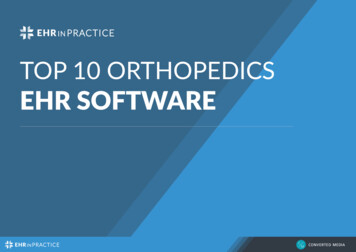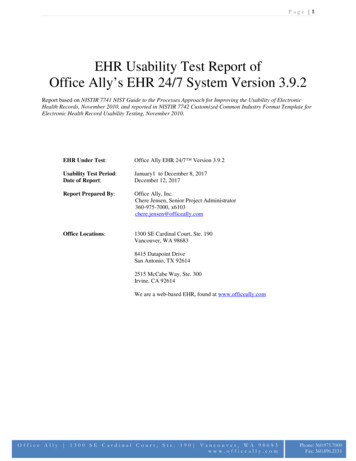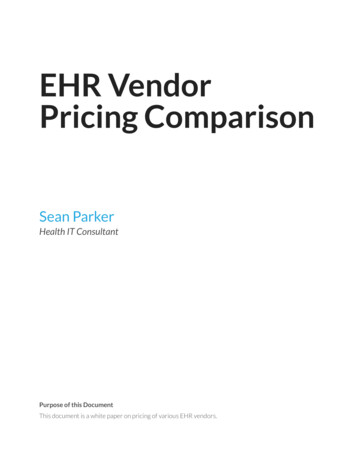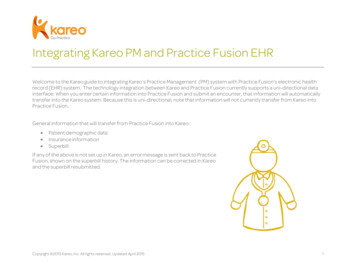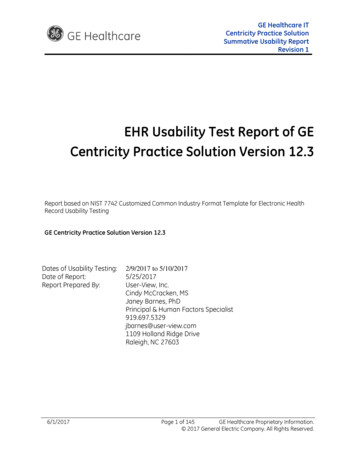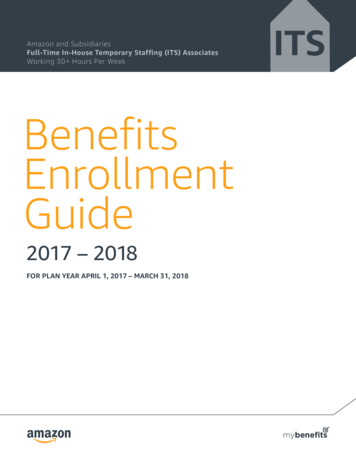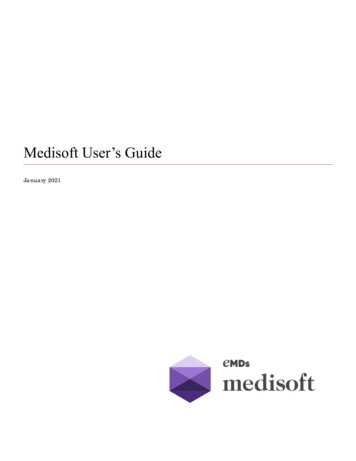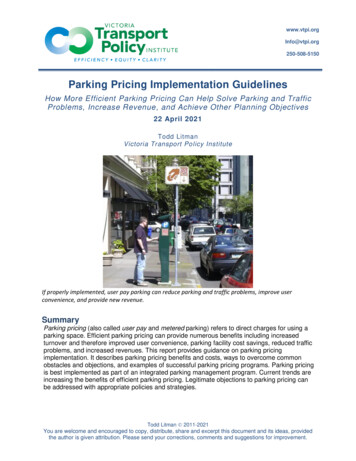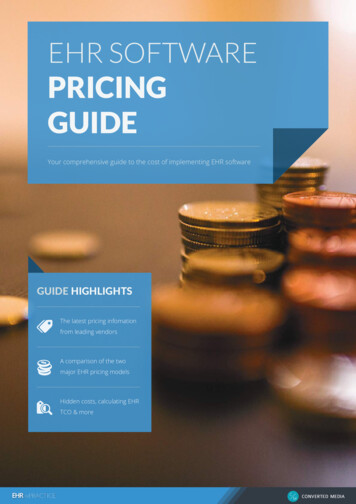
Transcription
EHR SOFTWAREPRICINGGUIDEYour comprehensive guide to the cost of implementing EHR softwareGUIDE HIGHLIGHTSThe latest pricing infomationfrom leading vendorsA comparison of the twomajor EHR pricing modelsHidden costs, calculating EHRTCO & moreEHR INPRACTICECMCONVERTED MEDIA
INDEX3Pricing Models5EHR Price List7Free EHR Explained9Calculating EHR TCO11EHR Hidden CostsEHR INPRACTICEEHR Software Pricing GuidePage 2CMCONVERTED MEDIA
PRICING MODELSJust as there are significant differences in EHR software functionality, the pricing models thesesystems operate on also differ. Just as functionality is an important consideration when makinga purchase decision, the pricing models a vendor can offer are equally important. Just as thetechnological capabilities of an EHR must be aligned with your practice’s goals, the pricing modelmust be conducive to system ROI.Even the perfect EHR from a technical standpoint can be all for naught if the economics of itspricing model pricing are unsustainable. With this caveat in mind, it is important that your EHRplatform presents a good technical fit within a pricing policy that is realistic given the financialclimate in your practice. Fortunately, the EHR market is competitive, with many pricing models tochoose from.PERPETUAL LICENSE PRICINGBroadly speaking pricing models align with the two main forms of EHR delivery: on-site EHRdeployment and web-based EHR delivery, also known as Software as a Service (SaaS). Typically,on-site delivery offers a perpetual license (allowing the customer to use the software indefinitely),however, the user must pay for ongoing costs to support and manage on-site data servers witha larger upfront cost. These ongoing fees also include updating and patching software whenrequired.As one can imagine, there are drawbacks related to paying a lump sum fee plus an annualmaintenance agreement. The main drawback of this EHR pricing model involves the significantcost at the onset of the agreement, coupled with the fact that these expenses are general nonrecoverable if the system does not meet your organization’s needs.SUBSCRIPTION PRICINGSaaS platforms typically operate a fixed monthly subscription pricing model or “pay-as- you-go”model. Although the initial setup cost for SaaS is usually lower than the equivalent perpetuallicense, SaaS-based EHR vendors typically attach usage parameters to this model. Theseparameters can be somewhat loose, for example EHR vendors may provide their software and allassociated updates for one monthly fee with a little or no limitations based on use. However, givenEHR INPRACTICEEHR Software Pricing GuidePage 3CMCONVERTED MEDIA
that they do not stand to benefit from collecting the same monthly fee from a user who uses asmall of amount of data compared to an intensive data user, the subscription is often scaled withusage. To achieve this, EHR vendors may link monthly charges to the number of system users orthe volume of activity on the system. An example of connecting volume of use to cost is found inthe pay per encounter pricing model in which the user pays for a set number of patient encountersfor a specified fee.“Even the perfect EHR from a technical standpoint can be all for naught ifthe economics of its pricing model pricing are unsustainable.”Given the variety of options available, the decision to adopt an EHR system rests on organizationalneeds and financial forecasts. If selecting a SaaS platform, keep in mind the associated EHR pricingmodel may help a practice avoid significant upfront costs; however if the scale of your practice (andproject) is larger, some perpetual license pricing models may be comparable in price when lookingat long-term total cost of ownership (TCO). Unfortunately, there is no magic formula to make thisdecision for you, and it will ultimately hinge on your organization’s ability to either front large sumsof money or pay in increments with more restrictions on usage.EHR INPRACTICEEHR Software Pricing GuidePage 4CMCONVERTED MEDIA
EHR PRICE LISTPricing Information displayed below is correct asof September 2015. Follow the source links formore information.EHR VENDOREHR PRODUCTPRICING MODELCOSTAdvancedMDAdvanced MD EHRMonthly subscription 729 / providerAmazing ChartsAmazing Charts EHRMonthly subscriptionAmazing ChartsAmazing Charts EHRPerpetualBizmaticsPrognoCis EHRMonthly subscription 250 / provideriCareCloud CentralCare Cloud EHRMonthly subscription 349 / provideriCharm TrackerChARM EHRMonthly subscription 0.50 / encounteriClinic SourceTherapy EMRMonthly subscription 79 / useriCureMDCureMD EHRMonthly subscription 295 / provideriEHR INPRACTICEEHR Software Pricing GuideSOURCEi 39 / seat 1200ilicense / clinician 1200 license /iclinicianPage 5CMCONVERTED MEDIA
EZDERMEZDERM EHRMonthly subscription 499idigiChartdigiChart EHRMonthly subscription 499 / providerieClinicalWorkseClinicalWorks EHRMonthly subscription 449 / provideriKareoKareo EHRFree*FreeiMcKessonPractice ChoiceMonthly subscription 349 / provideriOpenEMROpen EMRFree*FreeiOpenMRSOpenMRSFree*FreeiOSCAR EHRFree*FreeiPractice Fusion EHRFree*FreeiVistA EHRFree*FreeiWebPT EHRMonthly subscription 49 / provideriOscar Canada UsersSocietyPractice FusionDepartment ofVeteran AffairsWebPT* There is no such thing as a free lunch (or free EHR in many cases). Be sure to read our explanation of free EHRpricing models on page 6.Pricing correct as of 8th September, 2015. Check back for regular updates or contactcustomerteam@ehrinpractice.com to report pricing changes.EHR INPRACTICEEHR Software Pricing GuidePage 6CMCONVERTED MEDIA
FREE EHR EXPLAINEDAlthough it may seem counterintuitive, a free product (even a free EHR platform) can be monetized.One need only browse through the app store on their smartphone to understand that “freemium”has become an increasingly popular pricing model.We have all seen the popups when downloading a free app such as “contains in-app purchases,”“requires upgrades” or “shares user data with third parties” prior to downloading an app. Thesewarnings are not just the product of overly cautious legal departments at app development firms;rather they are an insight into how a free product can be monetized. Just as developers in themobile app space have found ways to monetize their “free” products, free EHR vendors also followsuit using some of the same revenue models.FREE EHR VIA AD REVENUEAds .love them or hate them are a permanent part of the IT landscape. Revenue models relying ontargeted advertising offer a way to monetize free software. Unfortunately, physicians and patientsbear the brunt of advertising channeled through our health systems. Targeted ads in free EHR usedata contained in the system to generate ad content. Therefore, a high incidence of a particulardisease in your EHR may result in targeted ads for pharmaceuticals that treat the disease. Ifyour physicicans click on the ads, the vendor receives revenue, you receive useful advertisinginformation everyone wins, in theory.Nobody wants to be bombarded with ads while entering care notes or reading a patient file.Perhaps even more troubling is the fact that data contained on the EHR system is often utilized toprovide the context for targeting ads, pushing the boundaries of the privacy and integrity of yourEHR system.FREE EHR VIA ADD-ONSThe theory behind this monetization strategy is rather straightforward; it goes as follows. You mayhave the basic version of a free EHR platform; however if you want to upgrade to a better versionof said platform, you must pay to add additional functionality. Think of it like buying a car, you canget the basic model for a great price; however when you want such amenities as built-in sat-nav,custom floor mats, and those sweet alloy rims, you will pay dearly. The same rules apply in the freeEHR INPRACTICEEHR Software Pricing GuidePage 7CMCONVERTED MEDIA
EHR world; a free base model may be available to practices while add-ons are required for moresophisticated EHR functionality or to achieve meaningful use. Alternatively, some EHR vendors willoffer their system for free as long as their billing system is implemented alongside. These billingsystems often take a commission on all billing to monetize the model.FREE EHR VIA PAY-TO-PLAYPay-to-play, as the name implies, means that the provider shifts the costs of the EHR system ontothe patient who would be required to pay, usually a yearly fee, to use the EHR system. For example,a paying patient may be able to use a web-based records portal and receive other electroniccare management benefits. However, non-paying patients will not be allowed to access all theadvantages of the system.“the decision as to whether or not free EHR is appropriate depends onyour ability to achieve practice buy-in for the system, despite its “freemium”inconveniences”The risk in this model, from a provider’s perspective, is that you run the risk of alienating patientsby shifting an administrative cost to them. Further, if the goal of EHR implementation is to improvehealthcare delivery, and only a portion of the patients pay for the system, only a portion of yourpractice processes will be improved through advanced EHR functionality.The term “free” in free EHR must be taken with the caveat that there is likely a revenue modelto monetize the services. Monetization, unfortunately, comes at the cost of potentially loweradoption (by the provider or patients) in the ad based and pay to play models and long-term costsrelated to upgrading beyond the basic system. As such the decision as to whether or not freeEHR is appropriate depends on your ability to achieve practice buy-in for the system, despite its“freemium” inconveniences.EHR INPRACTICEEHR Software Pricing GuidePage 8CMCONVERTED MEDIA
CALCULATING EHR TCOWhen evaluating an EHR system, consumers should look beyond the “out of the box” price andthink in terms of long-term and comprehensive cost estimates. One of the most comprehensiveand efficient measures for modeling long-term costs involves calculating the total cost of ownership(TCO). TCO is best defined as a full assessment of information technology and services costs overtime. TCO represents an accounting of all costs (both short term and long term, and direct andindirect) in order to create an accurate picture of the cost of operating an EHR and not merelypurchasing the system.When implementing an EHR system, the TCO should be an estimation of the “real” cost ofownership which often includes many overlooked expenses. Practices often make the mistake offocusing on “out of the box costs” such as purchase price, hardware and licensing, while minimizingor not fully considering some of the hidden costs of ownership.When considering TCO, an easy of way of accounting for costs is to divide them into direct andindirect costs. Directs costs include the costs easily attributed to the EHR system such as purchaseprice or maintenance agreements. On the other hand, indirect costs are those costs, which cannotbe immediately attributed to the EHR system and often require analysis from multiple functionsand departments.DIRECT COSTSWhen calculating TCO, direct costs are relatively clear cut. Direct costs for an EHR system includethe purchase price, additional software and hardware resources needed for the operation of thesystem, and the initial materials and labor required for system implementation. For example, thehardware includes new servers, desktop computers, tablets/laptops, printers, and scanners neededto operate the EHR system. Documentation of these costs can be as simple as recording theinvoice within your project budget.EHR consumers will often experience varying direct costs (and by association TCO) whencomparing SaaS versus on-site software. The Healthit.gov website publishes a useful illustration ofvariance between on site and SaaS software. Based on data collected by the Michigan Center forEffective IT Adoption, direct upfront cost, yearly cost, and five-year total cost of ownership (TCO) foron-site and SaaS EHR deployment are shown in the table on page 8 of this guide.EHR INPRACTICEEHR Software Pricing GuidePage 9CMCONVERTED MEDIA
On-PremiseAverageCostSaaSUpfrontYearly5 YearUpfrontYearly5 YearCostCostTCOCostCostTCO 33,000 4,000 48,000 26,000 8,000 58,000INDIRECT COSTSIndirect costs include staff time expended selecting the system and staff time diverted fromregular duties during implementation. When looking at indirect costs during implementationone of the primary factors involved will be staff time needed to implement the system. TCO fromthis perspective should consider training and technical support needed to not only implementthe system but to allow staff to learn the new system. Furthermore, lost productivity afterimplementation will need to be considered, particularly if the changes in the EHR system disruptcurrent practice workflow. As you can see, documentation of indirect EHR costs can requireongoing analysis or a complex forecast. The complexity of this task can often lead to inaccurate orexcluded costings if your EHR project plan doesn’t assign significant resources to these calculations.In making long-term forecasts, TCO provides the most useful measure of whether an EHR systemcan be justified from an ROI perspective. Practices should also realize that these estimates shouldaccount for all costs, even those that cannot be easily modeled. Costs may be higher under a TCO,but they will provide a more accurate picture of EHR system costs.EHR INPRACTICEEHR Software Pricing GuidePage 10CMCONVERTED MEDIA
EHR HIDDEN COSTSWhen documenting the costs of selecting and implementing an EHR system for your TCOcalculation, a useful strategy often lies in keeping a checklist of some of the lesser-known costs thatarise. The major EHR costs such as licensing fees and hardware costs do not require elaborationsince they represent the foundation of the system and the lion’s share of the costs. However,considering some of the less well-known costs relating to an EHR project can accomplish a greatdeal toward achieving a positive ROI.IMPLEMENTATION ASSISTANCEImplementation assistance encompasses all technical support required to implement the EHRsystem. This typically involves staff outside of your organization. Potential implementationassistance costs include bringing in an outside IT contractor, assistance with chart conversion orhardware and network installation.WORKFLOW REDESIGNSince a new EHR is being introduced to manage your organization’s processes, workflows will needto be analyzed, adjusted and reformed in light of new EHR functionality. Associated costs can bedirect, such as vendor consultation, or indirect, such as increased training or reduced short-termproductivity.TRAININGStaff will need to be trained on the new EHR system being introduced into your organization.Training extends to physicians, nurses, and office staff. In addition to training staff, a decisionregarding who will carry out the training will need to be made. Often the vendor will offer trainingservices. However, this could be limited, requiring in-house staff to conduct training in the future.MAINTENANCETechnology often malfunctions; this is a fact of modern life. This rule applies to a large-scale EHRsystem just as much as it applies to consumer technology.EHR INPRACTICEEHR Software Pricing GuidePage 11CMCONVERTED MEDIA
REDUCED PRODUCTIVITYWith a new EHR there will be a learning curve in which physicians become accustomed to using thenew system. This learning curve can reduce efficiency, resulting in lower patient throughput in theshort-term.SECURITY TOOLSHIPAA and HITECH require a high level of data security. In addition to mandated security measures,data breaches, even when your practice complies with the law, can be disastrous.CUSTOMIZATIONOut of the box EHR systems often require tweaks and adjustments to fit into the environmentthey are being used. This cost can be reduced if a system with a high level of user configuration isselected.UPGRADES AND ADD-ONSThe longer a system is in place, the lower the odds of requiring an upgrade. Particularly asmeaningful use expectations of EHR functionality change, an organization can anticipate upgradesand add-ons to be required.DATA MIGRATION AND CONVERSIONWhen conducting a change of EHR systems, all of the data contained within the old system willneed to be migrated to the replacement system. The scale of this cost is largely dependent on thehealth of your database prior to conversion.THIRD PARTY SOFTWAREEHR systems often require third party software to improve interoperability or to facilitate taskswithin the system. For example, organizations may use speech to text software to facilitate dictationof notes in the EHR.When analyzing the TCO (and subsequently, the ROI) of an EHR, all costs matter. Hidden EHRcosts that appear when least expected can overshadow what would have been a successfulimplementation. The best advice in this context is to be a pessimist and reserve budget rather thanletting hidden costs poke holes in your ROI calculations when you least expect it.EHR INPRACTICEEHR Software Pricing GuidePage 12CMCONVERTED MEDIA
This guide was written by Jeff Green, EHR in Practice Columnist, with contributionsfrom Tom Feltham, EHR in Practice EditorFor more exclusive EHR advice and resources follow EHR in Practice on social mediaThis guide was brought to you by www.ehrinpractice.comIcons made by Freepik, www.flaticon.com licensed by CC BY 3.0EHR INPRACTICEEHR Software Pricing GuidePage 13CMCONVERTED MEDIA
a purchase decision, the pricing models a vendor can offer are equally important. Just as the technological capabilities of an EHR must be aligned with your practice’s goals, the pricing model must be conducive to system ROI. Even the perfect EHR
